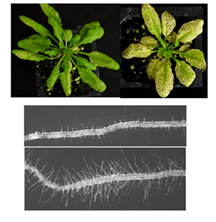
Gene thwarts some pathogens, gives access to others, could save crops
WEST LAFAYETTE, Ind. — A single gene apparently thwarts a disease-causing invader that creates a fuzzy gray coating on flowers, fruits and vegetables. But the same gene provides access to a different type of pathogen.

|
As Botrytis cinerea, a pathogen that makes strawberries gray and fuzzy, tries to invade a plant, the gene BIK1 recognizes the pathogen and sets off a defensive reaction. Botrytis is a type of pathogen that can infect and obtain nutrients from dead cells on a plant and actually secretes toxic substances into plant tissue in order to gain entry. Another type of pathogen, called a biotroph, must feed on live plant cells. As a strategy to contain a pathogen, plants actually kill their own cells at the site where a biotrophic pathogen is attempting to invade.
"This gene, BIK1, makes plants resistant to pathogens such as Botrytis, but it allows biotrophic pathogens to invade," said Tesfaye Mengiste, a Purdue plant molecular biologist and assistant professor of botany and plant pathology. "The mutant plant that doesn't have BIK1 actually shows decreased immunity to two pathogens, including Botrytis. But unexpectedly, it is completely resistant to virulent strains of the biotrophic bacteria."

|
The gene produces a protein located in the plant cell membranes and shows activity that is characteristic of proteins that act as enzymes. This finding led researchers to believe that these molecules give the early signals needed to set off a relay of biochemical events allowing the plant to fight off the pathogen, Mengiste said.
"Basically the BIK1 protein does this by regulating a plant defense hormone called salicylic acid," he said. "The amount of salicylic acid determines the type and level of a plant's response to the pathogen. This is very important in terms of disease resistance.
"In this paper, we speculate that there is an optimum level of salicylic acid that is required for pathogen defense. When that level is exceeded, in some cases it may promote susceptibility to other pathogens by interfering with other defense strategies of the plants."
The research team first looked at normal plants and then at the BIK1 mutant when they began to study the effect of different hormones on plant growth and pathogen defense, Mengiste said. The scientists were surprised to find that the mutants had reduced primary root growth but increased numbers of root hairs. Along with their other findings, this revelation is leading the scientists to future research.
"It looks like this gene actually links pathogen response to plant growth and development," Mengiste said. "But how a single protein regulates these two processes that are singularly independent, we don't know. That is the main purpose of our future studies.
"We need to figure out the details of how it regulates root growth and the length and amount of root hair. This may have implications in terms of nutrient absorption or total plant biomass."
The answers eventually could lead to increased crop yield and decreased produce loss due to Botrytis and other similar pathogens, he said.
Currently, the gray mold disease caused by Botrytis destroys about 10 percent of the grape crop annually and about 25 percent to 30 percent of tomato and strawberry crops in some seasons. It also infects many other fruits, vegetables, bulbs and a variety of flowers, including petunias, geraniums and chrysanthemums. Cool, humid weather fosters the fungus, which is spread by spores. The mold can appear in fields on growing plants and on strawberries, raspberries and other foods stored in the refrigerator.
Writer: Susan A. Steeves, (765) 496-7481, ssteeves@purdue.edu
Sources: Tesfaye Mengiste, (765) 494-0599, Mengiste@purdue.edu
Ag Communications: (765) 494-2722;
Beth Forbes, forbes@purdue.edu
Agriculture News Page
Related Web site:
Purdue Department of Botany and Plant Pathology
PHOTO CAPTION:
Tesfaye Mengiste, a Purdue plant molecular biologist, used the common laboratory test plant Arabidopsis to study how plants defend against pathogens. One pathogen, called Botrytis cinerea, causes gray mold disease on flowers, fruits and vegetables, including tomatoes and strawberries. (Purdue Agricultural Communication photo/Tom Campbell)
A publication-quality photo is available at https://www.purdue.edu/uns/images/+2006/mengiste-mold.jpg
PHOTO CAPTION:
The plant on the left is a normal laboratory test plant Arabidopsis. The plant on the right doesn't have the gene BIK1, which helps fight off Botrytis cinerea, a pathogen that causes the gray mold disease on flowers, fruits and vegetables. Tesfaye Mengiste, a Purdue plant molecular biologist, discovered the gene and that mutant plants without it have curly leaves and shorter primary roots but more root hairs, as shown in the bottom photo. (Photos courtesy of Tesfaye Mengiste laboratory)
A publication-quality photo is available at https://www.purdue.edu/uns/images/+2006/mengiste-mold2.jpg
Distinct Roles of the Membrane Anchored Botrytis Induced Kinase 1 in Arabidopsis Resistance to Necrotrophic and Biotrophic Pathogens
Plant resistance to disease is controlled by the combination of defense response pathways that are activated depending on the nature of the pathogen. We have identified the Arabidopsis Botrytis-induced serine/threonine protein kinase (BIK1) gene that is transcriptionally regulated by Botrytis cinerea infection. We show that inactivation of BIK1 causes severe susceptibility to necrotrophic fungal pathogens but enhances resistance to a virulent strain of the bacterial pathogen Pseudomonas syringae pv tomato. The response to an avirulent bacterial strain is unchanged, limiting the role of BIK1 to basal defense rather than race-specific resistance. The jasmonate and ethylene regulated defense response, generally associated with resistance to necrotrophic fungi, is attenuated in the bik1 mutant based on the expression of the plant defensin PDF1.2 gene. bik1 mutant plants show altered root growth characteristics producing more and longer root hairs demonstrating that BIK1 is also required for normal plant growth and development. Whereas the pathogen responses of bik1 are mostly dependent on salicylic acid (SA) levels, the non-defense responses are independent of SA. BIK1 is localized to the membrane suggesting a possible involvement in the early stages of recognition or transduction of pathogen response. Taken together, our data suggest that BIK1 modulates signaling of cellular factors required for defense responses to pathogen infection and normal root hair growth linking defense response regulation with that of plant growth and development.
To the News Service home page